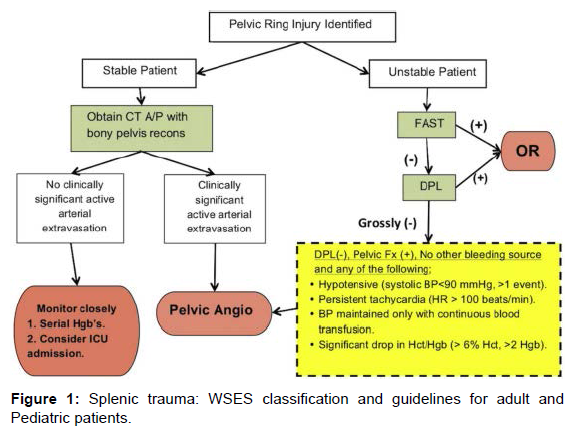Radiology Organization Course of Action and Practice for the Organization of Traumatic Splenic Injury
Received: 24-Jan-2022 / Manuscript No. roa-22-52240 / Editor assigned: 26-Jan-2022 / PreQC No. roa-22-52240(PQ) / Reviewed: 09-Feb-2022 / QC No. roa-22- 52240 / Revised: 14-Feb-2022 / Manuscript No. roa-22-52240(R) / Published Date: 21-Feb-2022 DOI: 10.4172/2167-7964.1000364
Image article
The administration of obtuse splenic wounds (BSI) has developed toward methodologies that stay away from splenectomy. There is developing reception of interventional radiology (IR) procedures in non-employable administration of BSI, with proof proposing a relating decrease in crisis laparotomy necessities and expanded splenic protection rates. Presently there are no UK public rules for the administration of obtuse splenic injury. This might prompt varieties in administration, notwithstanding the rearrangement of injury administrations in England in 2012 [1].
Awful injury keeps on assuming a significant part in mortality. Injury is the main source of death for individuals more youthful than 45 years old in the United States and around the world, representing roughly 10% of passing’s universally each year. During the previous ten years, death rates have kept on improving, partially in view of worked on clinical administration in the intense setting. Factors adding to this improvement incorporate better coordination of multidisciplinary care, quicker admittance to cutting edge imaging and intercessions, and expanding mastery at level I and auxiliary level emergency rooms. Utilization of no employable administration in explicit situations has likewise prompted better results. Mediation ought to be performed with convenience to limit discharge. In a patient with on-going blood misfortune, a prior intercession can forestall further monstrous blood misfortune, which has been broadly perceived as a reason for various organ disappointment and scattered intravascular coagulation. Perceiving that different angiographic mediations will fluctuate long of time, the interventional group ought to be prepared to intercede inside an hour from the time a joint choice is made to continue with angiography. This time slice off was made together through conversations with the American College of Surgery Committee on Trauma, and thought was given to the requirement for practical consideration offset with suitable emergency of some other analytic as well as remedial systems [2].
In the beyond 20 years, Tran’s catheter blood vessel embolization for awful injury has assumed a crucial part in further developing endurance, lessening dreariness, and diminishing usable blood misfortune. Its adequacy has been exhibited in numerous locales, including the liver, spleen, kidneys, and pelvis. Furthermore, embolization and vascular recreation with covered stents have been viewed as compelling in numerous vascular beds that are generally blocked off to employable intercessions, for example, subclavian, intercostal, lumbar, and phrenic conduits, and ought to be considered dependent upon the situation in those situations. In spite of the fact that embolization has been endeavoured in different organs too, for example, the inside or pancreas, its restricted utility in those settings must be taken into consideration [3].
Algorithmic Care of the Trauma Patient
The quick attention of the injury patient commands a multidisciplinary exertion among doctors from crisis medication, basic consideration, and injury medical procedure units. In the fitting setting, doctors from muscular medical procedure, vascular medical procedure, neurosurgery, and interventional radiology units assume vital parts. On account of the contribution of various clinical administrations, the arrangement of and adherence to treatment calculations individualized for every organization are essential for smoothed out, steady, and eventually upgraded care. Preferably, treatment calculations ought to be depicted for every injury situation. Making of such institutional calculations should be founded on proof based rules and accessible assets at that office. An illustration of the dull pelvic injury therapy calculation at Harborview Medical Centre (Seattle, Washington), the level I ER for the 4-state district of Washington, Alaska, Montana, and Idaho.
References
- Etienne Phipps, Wayne Shelton (1997) Forgoing Medical Treatment in Severe Facial Trauma 43:970-973.
- Haq E. Silva (2015) from the procedure to the dollar: language every interventionist should know to succeed in radiology economics 26:S169-S170.
- Eileen M Bulger, Janet Griffith Kastl, Ronald V Maier (2017) the history of Harborview Medical Centre and the Washington State Trauma System 2:e000091.
Citation: Albert P (2022) Mitigation of Diseases palliative Oncology in Pediatric Patients. OMICS J Radiol 11: 363. DOI: 10.4172/2167-7964.1000364
Copyright: © 2022 Albert P. This is an open-access article distributed under the terms of the Creative Commons Attribution License, which permits unrestricted use, distribution, and reproduction in any medium, provided the original author and source are credited.
Share This Article
Open Access Journals
Article Tools
Article Usage
- Total views: 2606
- [From(publication date): 0-2022 - Apr 19, 2025]
- Breakdown by view type
- HTML page views: 2060
- PDF downloads: 546

